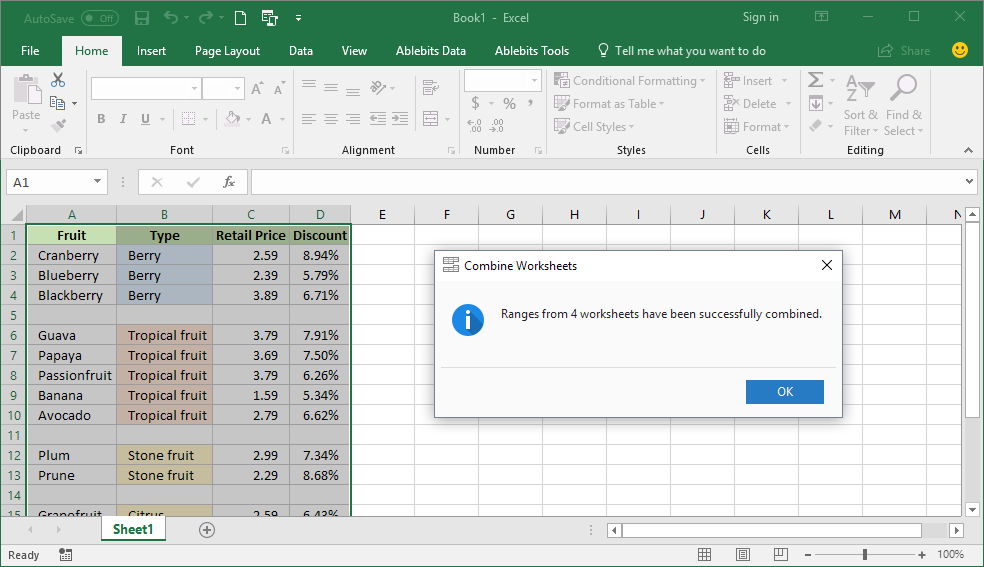5 Ways to Merge Excel Sheets onto One Page

Merging multiple Excel sheets into a single, comprehensive document can streamline data management, enhance data analysis, and increase productivity. Whether you're consolidating financial reports, compiling data sets, or organizing large datasets, Excel offers several methods to merge sheets effectively. Here are five detailed approaches to accomplish this task:
1. Using Excel’s Consolidate Feature

The Consolidate feature in Excel is designed to combine data from multiple ranges into a single range. Here’s how to use it:
- Open your Excel workbook containing the sheets you wish to merge.
- Select a blank sheet or a cell in the worksheet where you want the merged data to appear.
- Go to the Data tab and click on Consolidate.
- In the dialog box:
- Choose the function you want to use for consolidation, such as Sum, Average, or Count.
- Click on the first reference sheet and highlight the range you want to consolidate. Use the Add button to add this range.
- Repeat this process for each sheet or range you want to merge.
- Choose whether to link the data to the source or not.
- Press OK.
👉 Note: Using Consolidate doesn't create a new dataset but rather performs operations on existing data. If your sheets have identical structures, this method works well.
2. Copy and Paste Method

Sometimes, the simplest solutions work best:
- Select the range you need to copy from the source sheet.
- Right-click and choose Copy (or press Ctrl+C).
- Navigate to your destination sheet and right-click where you want to paste, then choose Paste (or press Ctrl+V).
| Step | Description |
|---|---|
| Select | Select the data range in the source sheet. |
| Copy | Copy the selected data. |
| Navigate | Move to the destination sheet. |
| Paste | Paste the copied data. |

👉 Note: This method is best for occasional or one-time merges where maintaining a link between the sheets is not required.
3. Power Query

Power Query is Excel’s data transformation tool, offering powerful features for merging data:
- From the Data tab, select Get Data > From File > From Workbook.
- Choose your Excel file. Select Combine > Merge Files.
- Power Query Editor will open, allowing you to transform and load data. Here you can:
- Append Queries to add data from different sheets to the end of each other.
- Merge Queries to combine data based on a key column or index.
👉 Note: Power Query can handle complex data transformation tasks, making it ideal for repetitive data merge operations.
4. Using Excel’s Workbook Relationships

If your data is spread across different workbooks:
- Open both workbooks.
- Go to the Data tab, select Relationships in the Data Tools group.
- Create a relationship between the sheets using a common field or index.
- Once linked, you can pull data from one sheet into another using VLOOKUP or similar functions.
This method provides flexibility by allowing for dynamic updates between sheets without the need for manual merging.
5. Macros or VBA for Automated Merging

For those who are comfortable with programming:
- Open the Visual Basic for Applications (VBA) editor from Developer tab or press Alt + F11.
- Insert a new module and write a macro to automate the merging process:
Sub MergeSheets()
Dim ws As Worksheet, sheet As Worksheet
Dim copyFrom As Range
Application.ScreenUpdating = False
Set sheet = ThisWorkbook.Sheets(“MasterSheet”)
For Each ws In ThisWorkbook.Worksheets
If ws.Name <> sheet.Name Then
‘Assuming data starts at A1 and continues to the end of the sheet
Set copyFrom = ws.Range(“A1”).CurrentRegion
copyFrom.Copy Destination:=sheet.Cells(sheet.Rows.Count, 1).End(xlUp).Offset(1, 0)
End If
Next ws
Application.ScreenUpdating = True
End SubThis macro will gather data from all sheets into a MasterSheet, copying the range from each sheet starting from A1 down to the last used cell.
👉 Note: VBA allows for more complex automation and can be customized to fit specific merging requirements or repetitive tasks.
To wrap up, merging Excel sheets effectively depends on your specific needs:
- Consolidate is great for summary functions on data with similar structures.
- Copy and Paste offers simplicity for one-time merges.
- Power Query provides extensive data transformation capabilities.
- Relationships link data dynamically between sheets.
- VBA Macros automate repetitive merging tasks.
The methods discussed ensure you can manage, analyze, and present data efficiently. Whether for regular reports or one-off projects, these techniques provide robust solutions tailored to various use cases.
What is the quickest way to merge Excel sheets?

+
The quickest method for one-time merging is often the Copy and Paste approach due to its simplicity. However, for recurring tasks, setting up a VBA macro might save more time in the long run.
Can I merge Excel sheets if they have different headers?

+
Yes, using Power Query, you can append sheets with different headers. You’ll need to ensure the data aligns in the way you want after the merge.
How can I automate merging Excel sheets on a schedule?

+
You can use VBA scripts combined with Windows Task Scheduler or similar tools to run Excel macros at scheduled times.